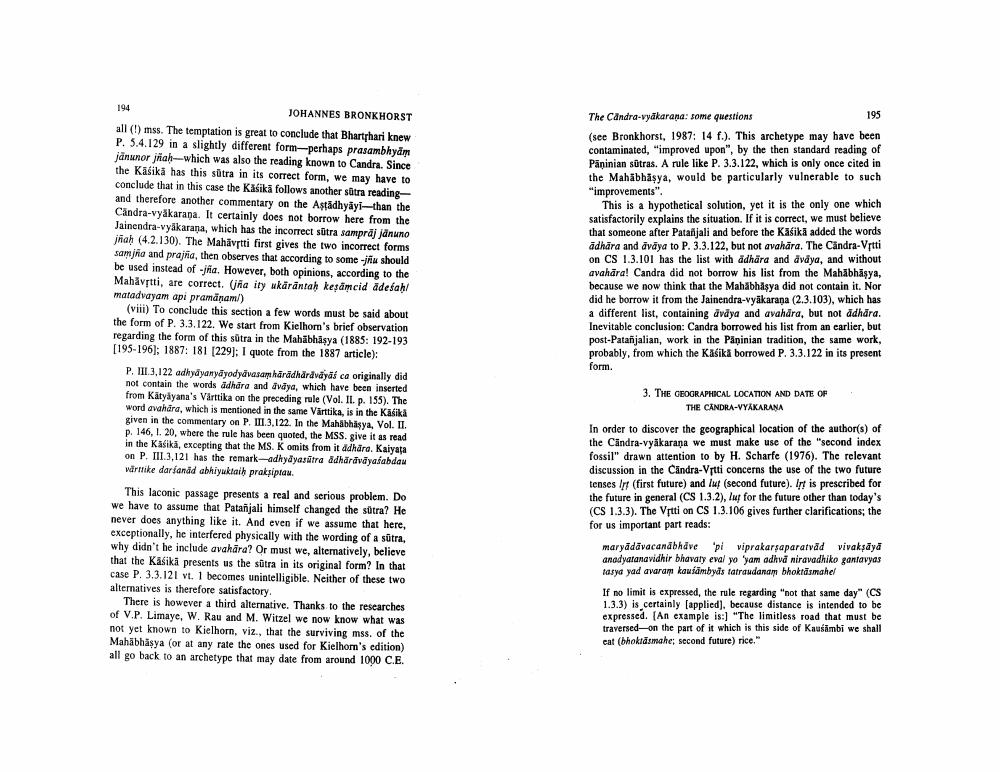Book Title: Candra Vyakarna Some Questions Author(s): Johannes Bronkhorst Publisher: Johannes Bronkhorst View full book textPage 7
________________ JOHANNES BRONKHORST all (1) mss. The temptation is great to conclude that Bharthari knew P. 5.4.129 in a slightly different form-perhaps prasambhyam jänunor jñaḥ-which was also the reading known to Candra. Since the Käsikä has this sutra in its correct form, we may have to conclude that in this case the Käsikä follows another sütra readingand therefore another commentary on the Astädhyayi-than the Candra-vyäkarana. It certainly does not borrow here from the Jainendra-vyakarana, which has the incorrect sutra sampräj jänuno jñaḥ (4.2.130). The Mahāvrtti first gives the two incorrect forms samjña and prajña, then observes that according to some -jñu should be used instead of -jña. However, both opinions, according to the Mahāvṛtti, are correct. (jña ity ukäräntaḥ kesämcid ädeśaḥl matadvayam api pramāṇam!) (viii) To conclude this section a few words must be said about the form of P. 3.3.122. We start from Kielhorn's brief observation regarding the form of this sütra in the Mahābhāṣya (1885: 192-193 [195-196]; 1887: 181 [229]; I quote from the 1887 article): 194 P. III.3,122 adhyāyanyāyodyāvasam kārādhäräväyāś ca originally did not contain the words adhara and avaya, which have been inserted from Kätyäyana's Värttika on the preceding rule (Vol. II. p. 155). The word avahara, which is mentioned in the same Värttika, is in the Käsikä given in the commentary on P. III.3.122. In the Mahabhäşya, Vol. II. p. 146, 1. 20, where the rule has been quoted, the MSS. give it as read in the Käsikä, excepting that the MS. K omits from it ädhära. Kaiyata on P. III.3,121 has the remark-adhyayasutra ädhärāvāyasabdau värttike daríandd abhiyuktaiḥ praksiplau. This laconic passage presents a real and serious problem. Do we have to assume that Patanjali himself changed the sütra? He never does anything like it. And even if we assume that here, exceptionally, he interfered physically with the wording of a sutra, why didn't he include avahara? Or must we, alternatively, believe that the Käsikä presents us the sutra in its original form? In that case P. 3.3.121 vt. 1 becomes unintelligible. Neither of these two alternatives is therefore satisfactory. There is however a third alternative. Thanks to the researches of V.P. Limaye, W. Rau and M. Witzel we now know what was not yet known to Kielhorn, viz., that the surviving mss. of the Mahäbhäṣya (or at any rate the ones used for Kielhorn's edition) all go back to an archetype that may date from around 1000 C.E. The Candra-vyakarana: some questions 195 (see Bronkhorst, 1987: 14 f.). This archetype may have been contaminated, "improved upon", by the then standard reading of Paninian sūtras. A rule like P. 3.3.122, which is only once cited in the Mahabhāṣya, would be particularly vulnerable to such "improvements". This is a hypothetical solution, yet it is the only one which satisfactorily explains the situation. If it is correct, we must believe that someone after Patanjali and before the Käsikä added the words ādhāra and āvāya to P. 3.3.122, but not avahāra. The Candra-Vṛtti on CS 1.3.101 has the list with ädhära and avaya, and without avahāra! Candra did not borrow his list from the Mahabhāṣya, because we now think that the Mahabhäşya did not contain it. Nor did he borrow it from the Jainendra-vyakarana (2.3.103), which has a different list, containing avaya and avahāra, but not ādhāra. Inevitable conclusion: Candra borrowed his list from an earlier, but post-Patanjalian, work in the Paninian tradition, the same work, probably, from which the Käsikä borrowed P. 3.3.122 in its present form. 3. THE GEOGRAPHICAL LOCATION AND DATE OF THE CANDRA-VYAKARANA In order to discover the geographical location of the author(s) of the Candra-vyäkarana we must make use of the "second index fossil" drawn attention to by H. Scharfe (1976). The relevant discussion in the Candra-Vrtti concerns the use of the two future tenses lyf (first future) and luf (second future). It is prescribed for the future in general (CS 1.3.2), lug for the future other than today's (CS 1.3.3). The Vrtti on CS 1.3.106 gives further clarifications; the for us important part reads: maryādāvacanābhāve 'pi viprakarsaparatvād vivakṣāyā anadyatanavidhir bhavaty eval yo 'yam adhva niravadhiko gantavyas tasya yad avaram kausāmbyās tatraudanam bhoktāsmahel If no limit is expressed, the rule regarding "not that same day" (CS 1.3.3) is certainly [applied), because distance is intended to be expressed. [An example is:] "The limitless road that must be traversed on the part of it which is this side of Kausāmbi we shall eat (bhokiäsmahe; second future) rice."Page Navigation
1 ... 5 6 7 8 9 10
